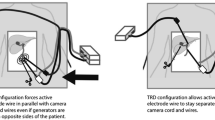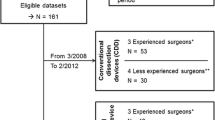Abstract
The specialty of laparoscopy has evolved with the advent of new technologies over the last few years. Energy-based devices and Ultrasonic dissectors are used with a lot of factors in play-including ergonomics and economics during surgery. Here an attempt is based to review the surgical efficacy and safety of these dissectors with importance to plume production and lateral thermal damage. The factors contributing to adversities to the dissectors are also to be noted. The strategy adopted was aimed at finding relevant studies from PubMed from 1995 to 2014. The basic principle of plume production and thermal damage are studied in this review. Factors contributing to the same that can lead to adversities during laparoscopic surgeries are identified. Summarizing key points that increase lateral thermal damage and plume production amongst different ultrasonic shears and suggesting a technique to identify the right balance between the existing dissectors was possible. The RF Device and USS are both useful and widely used and are more safer than monopolar devices. RF Device is considerably slower than USS, as it cannot achieve coagulation and cutting at the same time. Although USS definitely improvises dissection and has less thermal injury than RF Device, the clinical implications in balancing dissection efficacy with hemostasis need to be investigated further. The ideal haemostatic energy-based shear device would be one with excellent hemostatic results and visual acuity while allowing none or minimal thermal energy escape at the point of application. In our current setting, a combined use of both RF and USS device usage as applied in the particular situations has potential.




Similar content being viewed by others
References
Lallouf LB, Beri A, Klinger CH, et al. Practical hints for hemostasis in laparoscopic surgery. Minim Invasive Ther Allied Technol. 2007;16(1):45–51.
da Silva RD, Sehrt D, Molina WR, et al. Significance of surgical plume obstruction during laparoscopy. JSLS. 2014;18(3):69. doi:10.4293/JSLS.2014.00269.
Den Boer KT, de Jong T, Dankelman J, et al. Problems with laparoscopic instruments: opinion of experts. J Laparoendosc Adv Surg Tech A. 2001;11(3):149–55.
Emam TA, Cuschieri A. How safe is high-power ultrasonic dissection. Ann Surg. 2003;237:186–91.
Liberati A, Altman DG, Tetzlaff J, et al. The PRISMA statement for reporting systematic reviews and meta-analyses of studies that evaluate healthcare interventions: explanation and elaboration. BMJ. 2009;21:339. doi:10.1136/bmj.b2700.
Cimino W, Bond L. Physics of ultrasonic surgery using tissue fragmentation: part I. Ultrasound Med Biol. 1996;1:89–100. doi:10.1016/0301-5629(95)02021-7.
Pogorelić Z, Perko Z, Družijanić N, et al. How to prevent lateral thermal damage to tissue using the harmonic scalpel: experimental study on pig small intestine and abdominal wall. Eur Surg Res. 2009;43:235–40.
DesCoteaux J, Picard P, Poulin E, et al. Preliminary study of electrocautery smoke particles produced in vitro and during laparoscopic procedures. Surgical Endoscopy. 1996;10:152. doi:10.1007/BF00188362.
Barrett WL, Garber SM. Surgical smoke: a review of the literature. Is this just a lot of hot air? Surg Endosc. 2003;17(6):979–87 (Epub 2003 Mar 19).
Matthew MD, Stevens E, Mark Taylor S, et al. The air that we breathe’: assessment of laser and electrosurgical dissection devices on operating theater air quality. J Otolaryngol Head Neck Surg. 2014;43(1):39. doi:10.1186/s40463-014-0039.
Ball K. Survey of physicians attitudes toward surgical smoke. Can Oper Room Nurs J. 1995;13(4):18–21 (No abstract available).
Hoglan M. Potential hazards from electrosurgery plume–recommendations for surgical smoke evacuation. Can Oper Room Nurs J. 1995;13(4):10–6.
Ott DE, Moss E, Martinez K. Aerosol exposure from an ultrasonically activated (Harmonic) device. J Am Assoc Gynecol Laparosc. 1998;5(1):29–32.
Weld KJ, Dryer S, Ames CD, et al. Analysis of surgical smoke produced by various energy-based instruments and effect on laparoscopic visibility. J Endourol. 2007;21(3):347–51.
Schneider A, Doundoulakis E, Can S, et al. Evaluation of mist production and tissue dissection efficiency using different types of ultrasound shears. Surg Endosc. 2009;23(12):2822–6. doi:10.1007/s00464-009-0512-5 (Epub 2009 May 23).
Kim FJ, Sehrt D, Pompeo A, et al. Comparison of surgical plume among laparoscopic ultrasonic dissectors using a real-time digital quantitative technology. Surg Endosc. 2012;26:3408–12 (PubMed).
Kim FJ, Sehrt D, Pompeo A, et al. Laminar and turbulent surgical plume characteristics generated from curved- and straight-blade laparoscopicultrasonic dissectors. Surg Endosc. 2014;28(5):1674–7. doi:10.1007/s00464-013-3369-6 (Epub 2014 Jan 8).
Sartori PV, De Fina S, Colombo G, et al. Ligasure versus Ultracision in thyroid surgery: a prospective randomized study. Langenbecks Arch Surg. 2008;393:655–8.
Gözen AS, Teber D, Rassweiler JJ. Principles and initial experience of a new device for dissection and hemostasis. Minim Invasive Ther Allied Technol. 2007;16:58–65.
Perko Z, Pogorelić Z, Bilan K, et al. Lateral thermal damage to rat abdominal wall after harmonic scalpel application. Surg Endosc. 2006;20:322–4.
Kadesky KM, Schopf B, Blair GK. Proximity injury by the ultrasonically activated scalpel during dissection. J Pediatr Surg. 1997;32:878–9.
Amaral JF. Depth of thermal injury: ultracisionally activated scalpel vs. electrosurgery. Surg Endosc. 1995;9:226.
Humes DJ, Ahmed I, Lobo DN. The pedicle effect and direct coupling: delayed thermal injuries to the bile duct after laparoscopic cholecystectomy. Arch Surg. 2010;145:96–8.
Diamantis T, Kontos M, Arvelakis A, et al. Comparison of monopolar electrocoagulation, bipolar electrocoagulation, Ultracision, and Ligasure. Surg Today. 2006;36:908–13.
Diamantis T, Gialikaris S, Kontos M, et al. Comparison of safety and efficacy of ultrasonic and bipolar thermal energy: an experimental study. Surg Laparosc Endosc Percutan Tech. 2008;18:384–90.
Newcomb WL, Hope WW, Schmelzer TM, et al. Comparison of blood vessel sealing among new electrosurgical and ultrasonic devices. Surg Endosc. 2009;23:90–6.
Druzijanić N, Perko Z, Kraljević D, et al. Harmonic scalpel in transanal microsurgery. Hepatogastroenterology. 2008;55:356–8.
Smulders JF, de Hingh IH, Stavast J, et al. Exploring new technologies to facilitate laparoscopic surgery: creating intestinal anastomoses without sutures or staples, using a radio-frequency-energy-driven bipolar fusion device. Surg Endosc. 2007;21:2105–9.
Elemen L, Yazir Y, Tugay M, et al. LigaSure compared with ligatures and endoclips in experimental appendectomy: how safe is it? Pediatr Surg Int. 2010;26:539–45.
Družijanić N, Pogorelić Z, Perko Z, et al. Comparison of lateral thermal damage of the human peritoneum using monopolar diathermy, Harmonic scalpel and LigaSure. Can J Surg. 2012;55(5):317–21.
Lamberton GR, Hsi RS, Jin DH, Lindler TU, et al. Prospective comparison of four laparoscopic vessel ligation devices. J Endourol. 2008;22:2307–12.
Kim FJ, Sehrt D, da Silva RD, et al. Evaluation of emissivity and temperature profile of laparoscopic ultrasonic devices (blades and passive jaws). Surg Endosc. 2015;29(5):1179–84. doi:10.1007/s00464-014-3787-0.
Kim FJ, Chammas MF Jr, Gewehr E, et al. Temperature safety profile of laparoscopic devices: harmonic ACE (ACE), Ligasure V (LV), and plasma trisector (PT). Surg Endosc. 2008;22:1464–9. doi:10.1007/s00464-007-9650-9.
Sutton PA, Awad S, Perkins AC, et al. Comparison of lateral thermal spread using monopolar and bipolar diathermy, the Harmonic Scalpel and the Ligasure. Br J Surg. 2010;97:428–33.
Kwok A, Nevell D, Ferrier A, et al. Comparison of tissue injury between laparosonic coagulating shears and electrosurgical scissors in the sheep model. J Am Assoc Gynecol Laparosc. 2001;8:378–84.
Emam TA, Cuschieri A. How safe is high-power ultrasonic dissection. Ann Surg. 2003;237:186–91.
Author information
Authors and Affiliations
Corresponding author
Ethics declarations
Conflict of interest
None declared.
Additional information
Rajesh Devassy is a Consultant Advanced Laparoscopic Surgeon in Dubai London Clinic & Specialty Hospital, Dubai, UAE and Director of Gem Advanced Minimal Access Surgery Training Centre, University Hospital for Gynecology, Oldenburg, Germany; Sreelatha Gopalakrishnan is Specialists in Ob/Gynecologist at Dubai London Specialty Hospital, Jumeira, Dubai, UAE.
Rights and permissions
About this article
Cite this article
Devassy, R., Gopalakrishnan, S. & De Wilde, R.L. Surgical Efficacy Among Laparoscopic Ultrasonic Dissectors: Are We Advancing Safely? A Review of Literature. J Obstet Gynecol India 65, 293–300 (2015). https://doi.org/10.1007/s13224-015-0774-x
Received:
Accepted:
Published:
Issue Date:
DOI: https://doi.org/10.1007/s13224-015-0774-x




